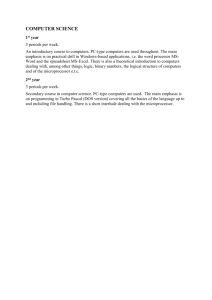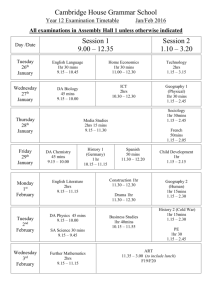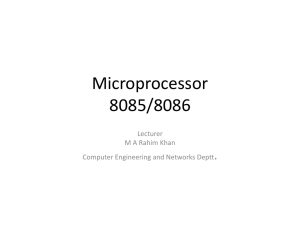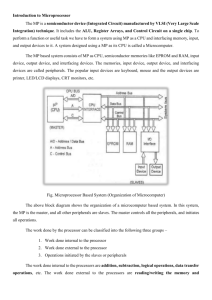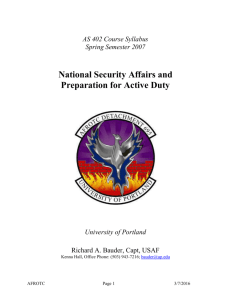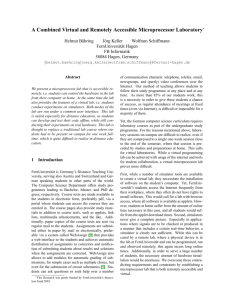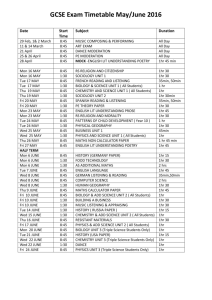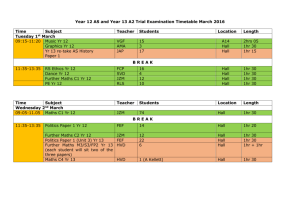EE-CSE 470 / 570
advertisement
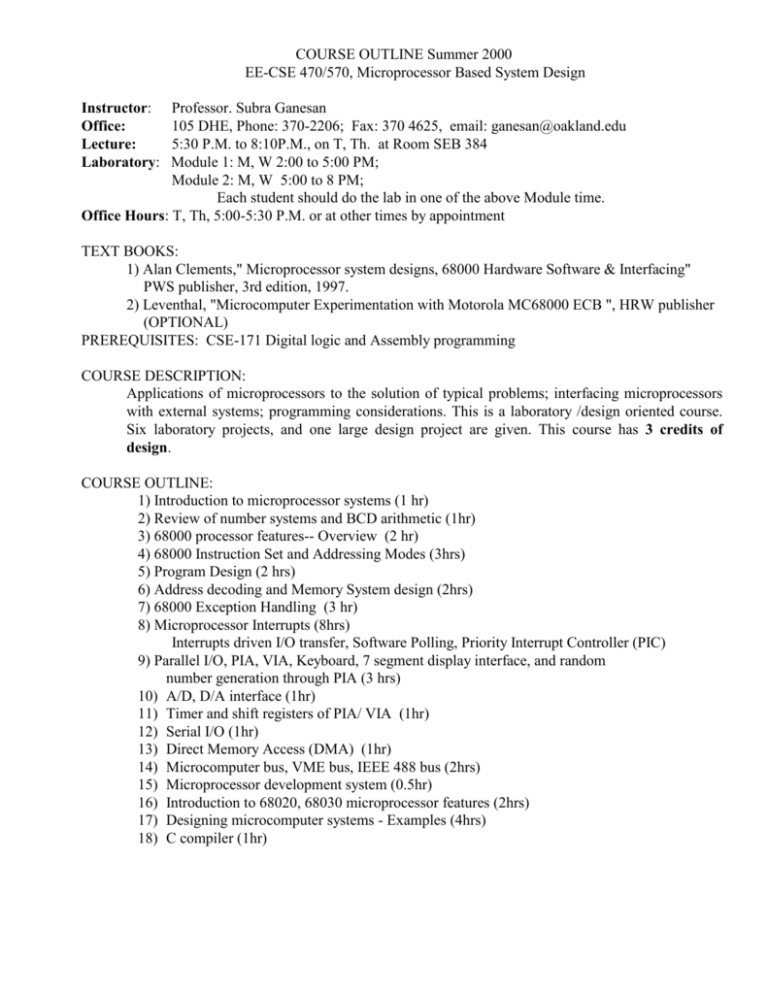
COURSE OUTLINE Summer 2000 EE-CSE 470/570, Microprocessor Based System Design Instructor: Office: Lecture: Laboratory: Professor. Subra Ganesan 105 DHE, Phone: 370-2206; Fax: 370 4625, email: ganesan@oakland.edu 5:30 P.M. to 8:10P.M., on T, Th. at Room SEB 384 Module 1: M, W 2:00 to 5:00 PM; Module 2: M, W 5:00 to 8 PM; Each student should do the lab in one of the above Module time. Office Hours: T, Th, 5:00-5:30 P.M. or at other times by appointment TEXT BOOKS: 1) Alan Clements," Microprocessor system designs, 68000 Hardware Software & Interfacing" PWS publisher, 3rd edition, 1997. 2) Leventhal, "Microcomputer Experimentation with Motorola MC68000 ECB ", HRW publisher (OPTIONAL) PREREQUISITES: CSE-171 Digital logic and Assembly programming COURSE DESCRIPTION: Applications of microprocessors to the solution of typical problems; interfacing microprocessors with external systems; programming considerations. This is a laboratory /design oriented course. Six laboratory projects, and one large design project are given. This course has 3 credits of design. COURSE OUTLINE: 1) Introduction to microprocessor systems (1 hr) 2) Review of number systems and BCD arithmetic (1hr) 3) 68000 processor features-- Overview (2 hr) 4) 68000 Instruction Set and Addressing Modes (3hrs) 5) Program Design (2 hrs) 6) Address decoding and Memory System design (2hrs) 7) 68000 Exception Handling (3 hr) 8) Microprocessor Interrupts (8hrs) Interrupts driven I/O transfer, Software Polling, Priority Interrupt Controller (PIC) 9) Parallel I/O, PIA, VIA, Keyboard, 7 segment display interface, and random number generation through PIA (3 hrs) 10) A/D, D/A interface (1hr) 11) Timer and shift registers of PIA/ VIA (1hr) 12) Serial I/O (1hr) 13) Direct Memory Access (DMA) (1hr) 14) Microcomputer bus, VME bus, IEEE 488 bus (2hrs) 15) Microprocessor development system (0.5hr) 16) Introduction to 68020, 68030 microprocessor features (2hrs) 17) Designing microcomputer systems - Examples (4hrs) 18) C compiler (1hr) LABORATORY There will be approximately 6 lab assignments using 68000 development boards, with emphasis on design. The laboratory projects will be both hardware and software assignments. Students should work individually on their labs. You can work on the lab assignments at any time when the lab is open and available. The lab will be checked by teaching assistant during the regularly scheduled lab period only. Each student has to Submit on or before August 9, a folder containing the lab Programs listings with the signature by the lab assistant indicating that the programs were demonstrated before the due date. For each lab include objective, a flow chart, hardware interface details, and opcode with comments. A disk with all the lab programs should be included in the folder. Labs emphasize design of software, hardware and interface. PROJECT Each student must work on a term project during the second half of the course. The project must be completed and tested before the due date mentioned below. Project title and brief abstract is due on: July 20 Progress report I (Hardware/ software detail and component list) July 27 Presentation in the lecture room August 17. Demonstration in the laboratory August 14-18 Final Project report is due on: August 18 EXAMINATION AND GRADE POLICY. Mid term Exam: (Open book; Design questions), August 1, 25% (Last day for withdrawal is August 1) Theoretical Design project, (Take Home, 1 week time) due on August 18 20% Laboratory Assignments 20% Project /Report / Demonstration/presentation: 30% Home work 5% GRADING POLICY: 55% and 95% of the total score will be 1.0 and 4.0 respectively. The grading curve is linear between 1.0 and 4.0. Grading policy may be modified if the average of the exams/score is very low. LAB ASSIGNMENT DUE ON (tentative) 1. Switch Input July 7 2. Key pad input and Screen display July 14 3. Displaying Messages July 21 4. A/D Converter and Interrupts July 25 5. D/A Converter and Sine Generation August 2 6. PI/T interrupts Academic Conduct: Students are expected to practice and uphold standards of academic integrity and honesty. Examples of dishonesty: cheating in exams, labs, and homework; plagiarizing the work of others, unauthorized collaborations on computer assignments. Please refer the Graduate or Undergraduate catalog for details. EE/CSE 470/570 DESIGN PROJECT Summer 2000 Instructor: Dr. S. Ganesan -----------------------------------------------------------You are expected to design, build, develop software and demonstrate a microprocessor-based system. A detailed project report, one per team, has to be submitted. Project report should contain, description of the project, objective, hardware design, software flowchart, interface design, program listing, suggestion for further work, references, and detail of the sensors or other ICs used in your project. You can work in a team of 2 or 3 students. This project can use any microprocessor (6805, 6809, 68HC11, 68000, TMS32010...). You can use the facility available in the school. You may borrow some hardware/ICs from Mr. Len Brown, if they are available readily. You have to return these components to get the grade. You can find most of the special components like speech chip, temperature sensor etc. at Radio Shack, R.S.Electronics, Active Electronics stores. The project must be sufficiently complex, emphasize both hardware and software. You are also expected to give an oral presentation on your project in the class. Submit Due on Project title, abstract team details .... July 20 Report I with preliminary design and component list July 27 Presentation in the class .... August 17 Demonstration in the lab .... August 14-18 Final Report due on .... August 18 DESIGN PROJECT SUGGESTIONS 1. 2. 3. 4. 5. 6. 7. 8. 9. 10. 11. 12. 13. 14. 15. 16. Anti lock brake system Security and alarm system Scrolling display on LED Matrix display (left, right, slow..) Temperature controller system Robot arm controller Digital filter Data acquisition system Clock with time, alarm display and sound/ speech Talking voltmeter Talking tire pressure Gauge DMA facility to 68000 board Combination lock / intruder alarm Sine and square wave generator Water level sense and management system Talking Toy and /or Games Any other project of interest. READING SEQUENCE FROM : 1. Chapter 1 2. Chapter 4, 3. Chapter 2 4. Chapter 3 5. Chapter 8 6. Chapter 6 7. Chapter 5 8. Chapter 4, 9. Chapter 8 10. Chapter 9 11. Chapter 7 12. Chapter 10 13. Chapter 11 Text book by Clement’s, 3rd edition pp. 203 -218 pp. 648- 682 pp. 218- 295 pp. 627- 647 LAB REPORT Lab report has to be submitted in a folder by each student. Note: Eventhough you do the lab as a team, the lab report is submitted by each student. Use the report submission guideline sheet enclosed with the first day handout. First describe briefly about the lab setup and EVB 68000 from Arnesh Inc. For each lab include objective, a flow chart, hardware interface details, and opcode with comments. A disk with all the lab programs should be included in the folder. Labs emphasize design of software, hardware and interface. Include in the appendix, details or data sheets of A/D, D/A or any other special chip you have used in the lab. There is no need to include the 68000 data sheet. HOME WORK ASSIGNMENT II Problem is from the text book by Clement 2.3, 2.4, 2.5, 2.7, 2.13, 2.27, 2.29 Due on ********************** Homework III. Refer the enclosed page. ******************* All the following problems are from the text book by Clement. Home Work IV: Due on problems: 3.1, 3.2, 3.4, 3.5 ************************************************************** Home Work V: Due on Problems: 8.2, 8.4, 8.7, 8.8, 8.9 ************************************************************** Home Work VI: Due on Problems: 6.1, 6.2, 6.3, 6.5, 6.6, 6.13, 6.19, 6.40, 6.22 ************************************************************** Home Work VII: Due on Problems: 4.9, 4.10, 4.11, 4.24, 5.1 a, 5.14, 5.17. **************************************************************
